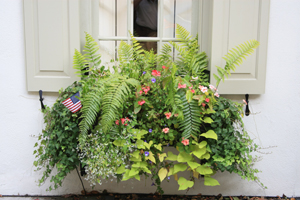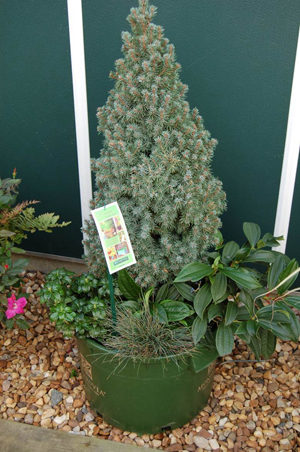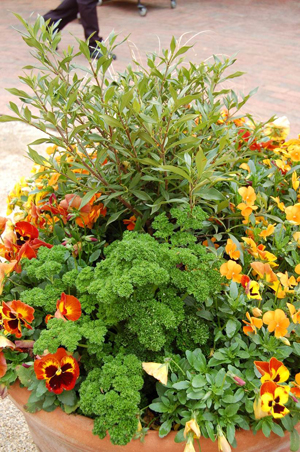Matthew Chappell and Bodie Pennisi
Department of Horticulture, Extension Specialists
 Figure 1.
Figure 1. Container gardening allows homeowners and businesses to “grow vertically” in spaces not typically reserved for planting. A good example is this window planter in Charleston, S.C., a city known for magnificent mixed planters and window planters.
Dating back to the ancient Hanging Gardens of Babylon, the art and practice of container gardening has enabled gardeners to grow plants virtually anywhere. Increased development has pushed urban gardeners to maximize impact in limited spaces and with limited resources, making container gardening even more popular. Gardeners who practice container gardening have many options: growing vertically, on (as opposed to in) compacted industrial soils and even where there is no soil (Figure 1). This publication offers information on types of plants suitable for mixed containers, with an emphasis on perennial and woody species and cultivars, as well as aesthetic qualities, cultural conditions and placement within the container.
Why Container Garden?
Combining ornate pots with plant themes creates a living element of self-expression and personal design. Mixed containers are heavily used in retail plant nurseries and commercial properties as focal points to draw the attention of consumers and clients. Novice gardeners can enjoy ready-made containers (also called container gardens, or combos). For more adventurous and knowledgeable gardeners, there are myriad plants and containers to choose from. Mixed containers can combine annuals, perennials, woody shrubs and even small trees. As few as three different plants can be planted to achieve the desired effect. In general, small combo containers (including baskets) contain annual plants that are rotated with seasonal color (e.g., cool-season annuals followed by warm-season annuals). Larger containers are often planted with perennials, shrubs and/or small trees in addition to annuals. Regardless of the source or plants selected, container gardening can add visual interest to draw the eye, direct traffic and provide focal points that can either grab attention or screen unsightly landscape or architectural elements.
| Terms |
| Annual |
A plant that completes its life cycle in less than one year. Cool-season annuals are planted in fall (e.g., pansy, snapdragon, ornamental kale). Warm-season annuals are planted in late spring (e.g., petunia, zinnia, vinca). Annuals as a group are unable to withstand both summer heat and winter cold (Thomas, 2012). |
| Herbaceous Perennial |
A plant, including many bulbs, that completes its life cycle in two or more years and can withstand both summer and winter conditions (e.g., daylily, hosta, canna) (Thomas et al., 2012). Herbaceous perennials typically lose their above-ground foliage in winter. |
| Tender Perennial |
An annual that happens to survive the winter in Georgia; however this definition is very weather-dependent. Some tender perennials may be annuals seven out of 10 years! These species are of tropical origin (e.g., pigeon berry (duranta), sun coleus, elephant ears). Tender perennials may be species that grow to be shrubs and even small trees in their native habitat; however, when grown without winter protection, they typically lose their above-ground stems and behave as temperate zone perennials. |
| Shrub |
A perennial plant with multiple woody stems that are retained during winter (e.g., pieris, loropetalum, cotoneaster). |
| Tree |
A perennial plant with woody stems, typically larger than a shrub, and with a single or multiple trunks (e.g., Japanese maple, crape myrtle, dogwood). |
| Evergreen perennial, shrub or tree |
A plant that retains its foliage year-round (e.g., hellebore (Christmas and Lenten Rose), Aspidistra (cast iron plant), broadleaf (camellia) and needled evergreens (juniper)). |
| Deciduous shrub or tree |
A perennial plant that loses its foliage in winter (e.g., native azalea, crape myrtle). |
Design Principles
Themes
 Figure 2.
Figure 2. Wholesale growers are using mixed containers to provide customers with an instant effect while increasing the value-added profit associated with mixed containers, such as this Monrovia® combination container.
The first and most important step in designing a successful mixed container is creating a theme. The opportunities for container creation are abundant and only limited by the gardener's creativity and experience. Themed containers allow the designer to stay on track when selecting the plants and for that reason it is always best to begin container gardening by creating a unifying theme, be it a color, texture, use or size of plant material.
 Figure 3.
Figure 3. This mixed container uses a combination of winter annual plants (parsley and pansies) with the evergreen shrub Gardenia 'Frostproof'. The winter annuals will be replaced in spring with summer annuals to provide continual color.
In addition to the popular “Thriller, Spiller, Filler” mixed containers (Silk, 2004), more specific and daring themes are becoming popular. Some examples of themed containers include food-based container